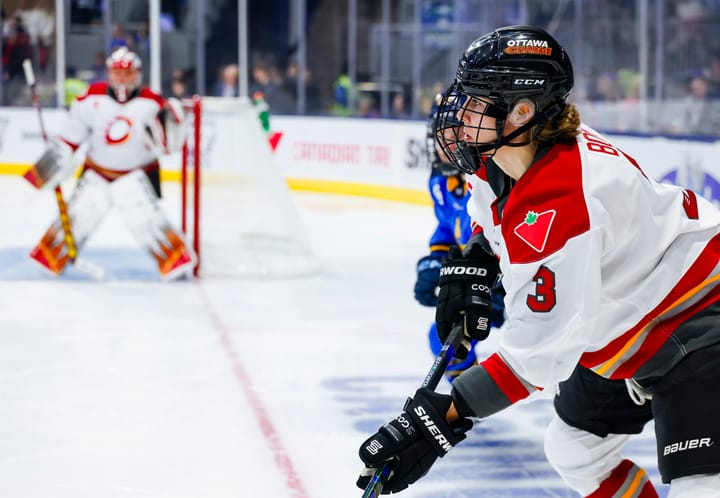The road to expansion: six cities the PHF could put new teams in
From the Six to a terrific 10, but where will four new teams go?
With the announcement on Jan. 18 of the Board of Governors’ $25 million investment in the PHF came a bit of a buried lede: that being the expansion of the league to 10 teams come the 2023-24 season.
Related
PHF to increase salary cap, expand next season
The long-awaited Montreal franchise will reportedly make its debut next season, along with a not-yet-mentioned U.S. team reported to be in the Eastern time zone, according to an article by Marisa Ingemi for the Seattle Times on Jan. 27. Two more teams will be created the following season if all goes according to plan, though nothing concrete has been said about the locations.
But while we’re on the topic of expansion, I think there are a few cities the league could really plant roots in. Some of them are a bit more obvious than others, but I think each of these has its pros and cons when it comes to rounding out a full-fledged league. Let’s take a look at where we could see the league’s next team come from:
Detroit
We’ve already heard rumblings of potential expansion to Motor City, although under the potential ownership of someone we’d rather not think about right now. Still, if the PHF is looking to tie Minnesota to the rest of the league, this would be a great place to start. Several cities on this list fit that description, as well as a place for some of the immense NCAA and ACHA talent in the Midwest to continue their post-secondary hockey careers.
Pros: Like the next city on this list, Detroit is able to provide a nice stopping point on the way to Minnesota should we ever get an expanded schedule that includes back-to-back games like that. Also, a huge possibility for homegrown talent to thrive.
Cons: Flying to and from in winter. Just ask the Beauts. Also, there isn’t really an established market for women’s hockey above youth teams, which would make it stand out, but marketing likely a bit more difficult without some help from (maybe) the Red Wings.
Chicago
This is another option for those of us hoping that gap in the Midwest can get filled up soon. Minnesota is the furthest of the six PHF teams and thus has to spend the most just to travel to play the rest of the league. Chicago provides a nice midpoint between the Twin Cities and its next closest neighbor, Buffalo, and is (I believe) a big enough city to handle a pro women’s team. This would make it a fairer playing field, literally, and on top of that the Second City certainly needs a new hockey team to cheer for, so it’s a perfect fit.
Pros: As mentioned, it geographically makes things a lot easier for Minnesota, plus when I searched for women’s hockey in the Chicago area I did come across one team, the Chicago North Stars, that has quite a bit of a similar feel to the Whitecaps in their barn-storming days. It’s unclear whether or not they’re still active, but if they are... well, hello.
Cons: There is a LOT of hockey in this area, and while that’s definitely a great thing, unlike one of the other cities on this list, a team here might have a harder time carving out its own identity, if not finding a market (because there definitely is one, it’s just very saturated and unfortunately a lot of noise would surround its potential brother in the NHL as well).
Pittsburgh
Once we found out that the first U.S. expansion team would potentially be in the Eastern time zone, I was mildly disappointed, but immediately thought we might see the league’s first Pennsylvania team set up shop in the western end. The PHF (then NWHL) has been here before, holding its second-ever All-Star Game at UPMC Lemieux Sports Complex, the Penguins’ practice rink. There is again tons of talent to pull from, with RMU and Mercyhurst close by and Penn State just a couple of hours away, to say nothing of some of the neighboring states and their options. Also, there’s a convenient geographic rivalry with Buffalo just up north. I’m nothing if not self-serving.
Pros: Taps into PA’s talent pool, close to neighboring Ohio and Maryland as well — and there’s HUGE potential for former PHFers like Kelley Steadman and Brianne McLaughlin to get involved.
Cons: With Buffalo and Toronto almost directly to the north, could make this corridor a bit cluttered — but at least travel would be easy!
Milwaukee
Obviously this was going to come up if we were going to mention the Midwest. Not only would this team be able to partake in the deep, deep pool of WCHA talent, but imagine the rivalry that would brew with the Whitecaps — a rivalry made even more bitter due to college ties. Ooooh, boy. I’m getting excited just thinking about some of those games, and we don’t even know if it’ll ever happen yet.
Pros: Obviously, built-in rivalry and ease of travel for the Whitecaps, plus can help provide a place for even more NCAAers to play after college, which is always a good thing.
Cons: With it being another Midwestern team, could put strain on the league to finance travel (provided I’m correct in my assumption the league would own any expansion teams first... I could be wrong).
Washington, D.C.
Want a gateway to the South? You got it — and it’s full of girls’ and women’s hockey at all levels. From U12 to U19 teams, college club teams in nearby Maryland, and the Mid-Atlantic Women’s Hockey League, it’s a safe bet you’ll get some instant fans and also be able to cultivate some homegrown talent.
Pros: As with almost all of the teams on this list, there’s an NHL presence and potential for partnership; it’s also close enough to the existing teams to make travel decent enough to be worth it, plus again, built-in fanbase.
Cons: Of course, even further for the Whitecaps and Canadian teams to travel to.
Nashville
So this is the most far-flung of the locations I thought of, but not without reason; after all, the 2019 All-Star Game was held right in Music City. Unfortunately, we haven’t heard a whole lot since, which makes this Southern outpost the least likely of the ones mentioned here. That doesn’t mean we can’t have a whole lot of fun trying to think of colorful mascots and uniforms, or what country artist would drop the puck at the inaugural home game. (My money would be on Kacey Musgraves.)
Pros: Some familiarity, plus any team here would certainly have a distinct identity and could easily draw hockey fans from some overlooked corners of the country. North Carolina is also right next door.
Cons: Obviously, it’s more than a little out of the way for the rest of the league. I don’t see any Southern expansion, really, until we can button up the Midwest and really get established with the Canadian teams. Which is a bit of a shame.
What does this mean for the PHF?
Well, obviously it means the league feels comfortable enough to start looking outside the six teams it already has and really make this a dream come true for athletes everywhere. Like basically everything else about this investment, it shows the Board of Governors has the confidence in the league to really give it more than just a passing thought; instead, they’re looking to build it to last.
Of course, with that optimism comes a dose of concern. Ten teams, two years from now is ambitious for any league, but especially one like the PHF that has a lot to consider with regard to not only finances, but player representation, communications, and transparency. (More on that in a column later this week.) No one (well, mostly no one) wants to see this league fold like so many others before it, and part of that means tempering high hopes with realistic goals.
Now, if it does happen, I will gladly eat the biggest, fattest crow you can find, feathers and all. But part of me hopes they walk back juuust a bit and try to look at the bigger picture when it comes to sustainability. Also, when it comes to this pandemic, which sadly doesn’t look to have an end in sight currently, despite the actions of people who wish to pretend otherwise.
I’m optimistic, yet still so very, very cautious. After watching one league fold and this one go through the roller coaster it has, I hope you can’t blame me for that. In the meantime, let’s hope we see one or more of these cities welcome the PHF into the fold.





Comments ()